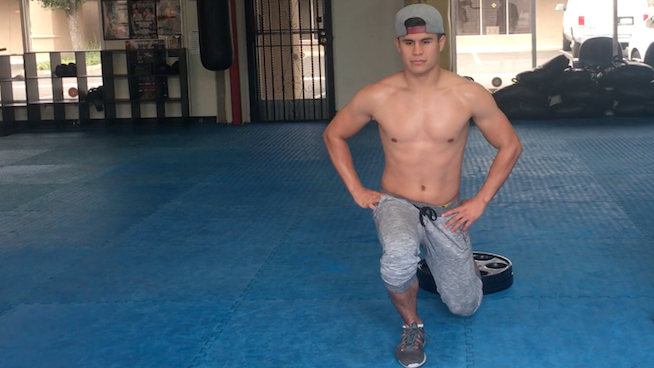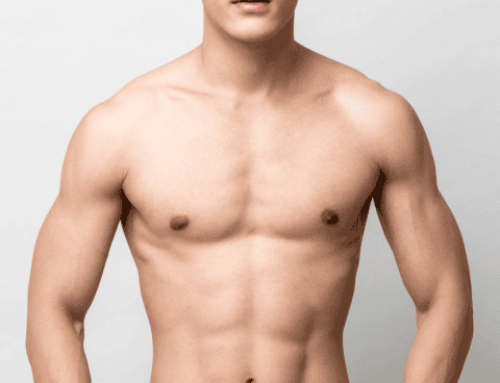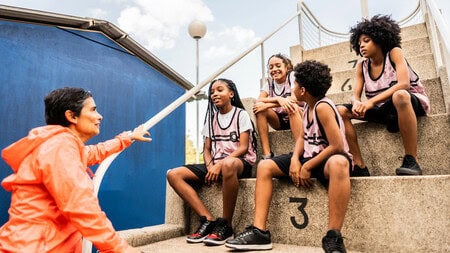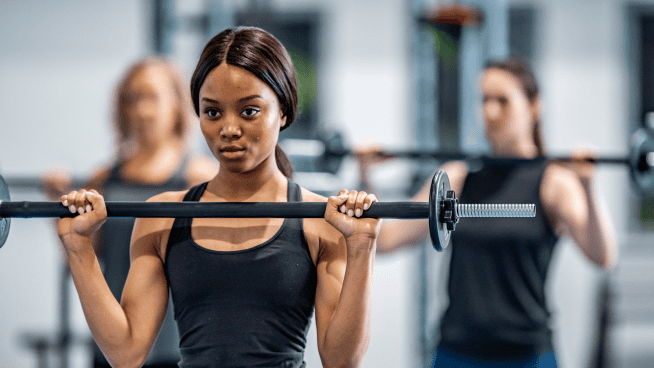Develop Single-Leg Strength With Bulgarian Lunges
The Bulgarian Lunge is an excellent exercise for developing lower-body strength and stability, while posing a lower injury risk than many traditional lower-body resistance exercises.
You could say the Bulgarian Lunge is the cousin to the Bulgarian Squat, an exercise that’s become a staple in the strength and conditioning programs of many top trainers. The two cousins feature similar attributes that maximize strength and power and train unilaterally while using relatively lighter loads that are easier on the joints.
RELATED: Try This Bulgarian Split-Squat Variation for Powerful Legs
Bulgarian Squats became hugely popular because they place less stress on the lower back and knees than a traditional Back Squat. The mobility requirements are also generally easier for most athletes. And because it’s a unilateral exercise, you’re able to strengthen your legs using lighter loads relative to a Back Squat and address any muscular imbalances that might not be addressed during a bilateral lift.
But one issue pops up with Bulgarian Squats—hip/groin mobility. One key difference between the Bulgarian Lunge and the Bulgarian Squat is the angle of elevation for the rear foot. With the Bulgarian Squat, your foot is elevated almost to hip level. This can be challenging for individuals with groin/hip injury history or mobility issues.
RELATED: BOSU Bulgarian Lunge Hop With Drew Brees
With the Bulgarian Lunge, your foot is placed on a lower platform, reducing those challenges.

How to do the Bulgarian Lunge
1. Place your rear foot facing forward on an elevated platform; 3 to 5 inches in height is sufficient. (I like using one or two weight plates.) You can stand on the ball of your rear foot with it placed flat or on your tiptoes.
2. Place your front foot with ample space forward to perform a Lunge. Your front foot can be pointed forward or slightly outward. (The outward position is easier for beginners.)
3. During the movement, your upper body should remain fixed in an upright position. You can initially do the move with just your body weight, but weights held in the goblet or front rack position can help you maintain postural balance.
4. During the descent, keep your torso above your hips at all times.
5. As you descend slightly forward, maintain your torso and hips over your center of gravity—which should be the midpoint between your feet.
[cf]skyword_tracking_tag[/cf]RECOMMENDED FOR YOU
MOST POPULAR
Develop Single-Leg Strength With Bulgarian Lunges
The Bulgarian Lunge is an excellent exercise for developing lower-body strength and stability, while posing a lower injury risk than many traditional lower-body resistance exercises.
You could say the Bulgarian Lunge is the cousin to the Bulgarian Squat, an exercise that’s become a staple in the strength and conditioning programs of many top trainers. The two cousins feature similar attributes that maximize strength and power and train unilaterally while using relatively lighter loads that are easier on the joints.
RELATED: Try This Bulgarian Split-Squat Variation for Powerful Legs
Bulgarian Squats became hugely popular because they place less stress on the lower back and knees than a traditional Back Squat. The mobility requirements are also generally easier for most athletes. And because it’s a unilateral exercise, you’re able to strengthen your legs using lighter loads relative to a Back Squat and address any muscular imbalances that might not be addressed during a bilateral lift.
But one issue pops up with Bulgarian Squats—hip/groin mobility. One key difference between the Bulgarian Lunge and the Bulgarian Squat is the angle of elevation for the rear foot. With the Bulgarian Squat, your foot is elevated almost to hip level. This can be challenging for individuals with groin/hip injury history or mobility issues.
RELATED: BOSU Bulgarian Lunge Hop With Drew Brees
With the Bulgarian Lunge, your foot is placed on a lower platform, reducing those challenges.

How to do the Bulgarian Lunge
1. Place your rear foot facing forward on an elevated platform; 3 to 5 inches in height is sufficient. (I like using one or two weight plates.) You can stand on the ball of your rear foot with it placed flat or on your tiptoes.
2. Place your front foot with ample space forward to perform a Lunge. Your front foot can be pointed forward or slightly outward. (The outward position is easier for beginners.)
3. During the movement, your upper body should remain fixed in an upright position. You can initially do the move with just your body weight, but weights held in the goblet or front rack position can help you maintain postural balance.
4. During the descent, keep your torso above your hips at all times.
5. As you descend slightly forward, maintain your torso and hips over your center of gravity—which should be the midpoint between your feet.
[cf]skyword_tracking_tag[/cf]









